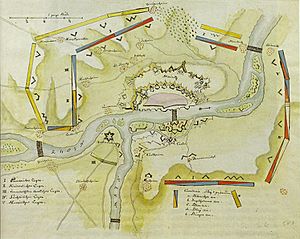Siege of Mainz (1793) facts for kids
Quick facts for kids Siege of Mainz |
|||||||
|---|---|---|---|---|---|---|---|
| Part of the French Revolutionary War | |||||||
 |
|||||||
|
|||||||
| Belligerents | |||||||
|
|||||||
| Commanders and leaders | |||||||
| Strength | |||||||
| 22,000-23,000 men, 184 cannons |
36,000-43,000 men, 207 cannons |
||||||
| Casualties and losses | |||||||
| 4,000 killed or wounded 18,000-19,000 captured (released after the battle) |
3,000 killed or wounded | ||||||
The Siege of Mainz was a major event during the French Revolutionary War. It took place from April 14 to July 23, 1793. A group of armies, called a coalition, surrounded and attacked the city of Mainz. These armies were from Prussia, Austria, and other German states, all part of the Holy Roman Empire. They fought against the French revolutionary forces who controlled Mainz. After many weeks of fighting, the coalition forces won and captured the city.
Contents
The Battle for Mainz
The battle for Mainz began with attempts to talk things out. The allied forces, especially the Prussians, first tried to negotiate with the French. They hoped to avoid a full-scale attack. However, these talks did not succeed. Because the negotiations failed, the coalition began to bombard the city. This heavy shelling started on the night of June 17.
Life Inside the Besieged City
Inside Mainz, the siege and constant bombing created a lot of tension. The citizens, the city government, and the French military leaders faced many challenges. The French war council had been in charge since April 2. On July 13, the city's local government was removed. This made the remaining people in Mainz even more determined to resist.
French Surrender and Aftermath
The French forces inside Mainz were waiting for help, but no relief army arrived. With no hope of outside support, the French war council had to start talking with the allied forces on July 17. The remaining French soldiers officially gave up on July 23.
Almost 19,000 French troops surrendered at the end of the siege. They were allowed to go back to France. However, they had to promise not to fight against the allies for one year. Because of this promise, these soldiers were later sent to fight against French royalists. These royalists were rebelling in a region of France called the Vendée. As the French soldiers left Mainz, they sang La Marseillaise, which was a famous French war song.
Impact on Mainz
The Siege of Mainz had a huge impact on the city and its people. Mainz had been home to the Republic of Mainz. This was the first democratic state ever formed on what would later become German land. After the siege, this democratic state was ended. A Prussian commander was put in charge of the city.
City Destruction and Changes
The bombing during the siege caused a lot of damage to Mainz. Many buildings were destroyed. These included civil buildings and grand palaces. For example, the comedy house, the beautiful Favorite palace, and the House of the Cathedral Provost were ruined. Several churches, like Liebfrauen, the church of the Society of Jesus, St. Crucis, and St. Jacob, were also destroyed. Even the famous cathedral was badly damaged.
The occupation and siege changed Mainz forever. The city had been an important part of the old imperial structure, serving as an electoral residence. This meant it was a very important religious and political center. The events of 1793 marked the end of this era. Mainz lost its special status as "Golden Mainz" (Aurea Moguntia), its Latin nickname.
Wider European Interest
The shelling of Mainz was a big topic of discussion across Europe. Many people traveled to the area just to watch the siege unfold. Even famous writer Johann Wolfgang von Goethe was there. He joined Duke Carl August of Saxe-Weimar during the siege. Goethe later wrote a well-known book about his experiences during the event.

